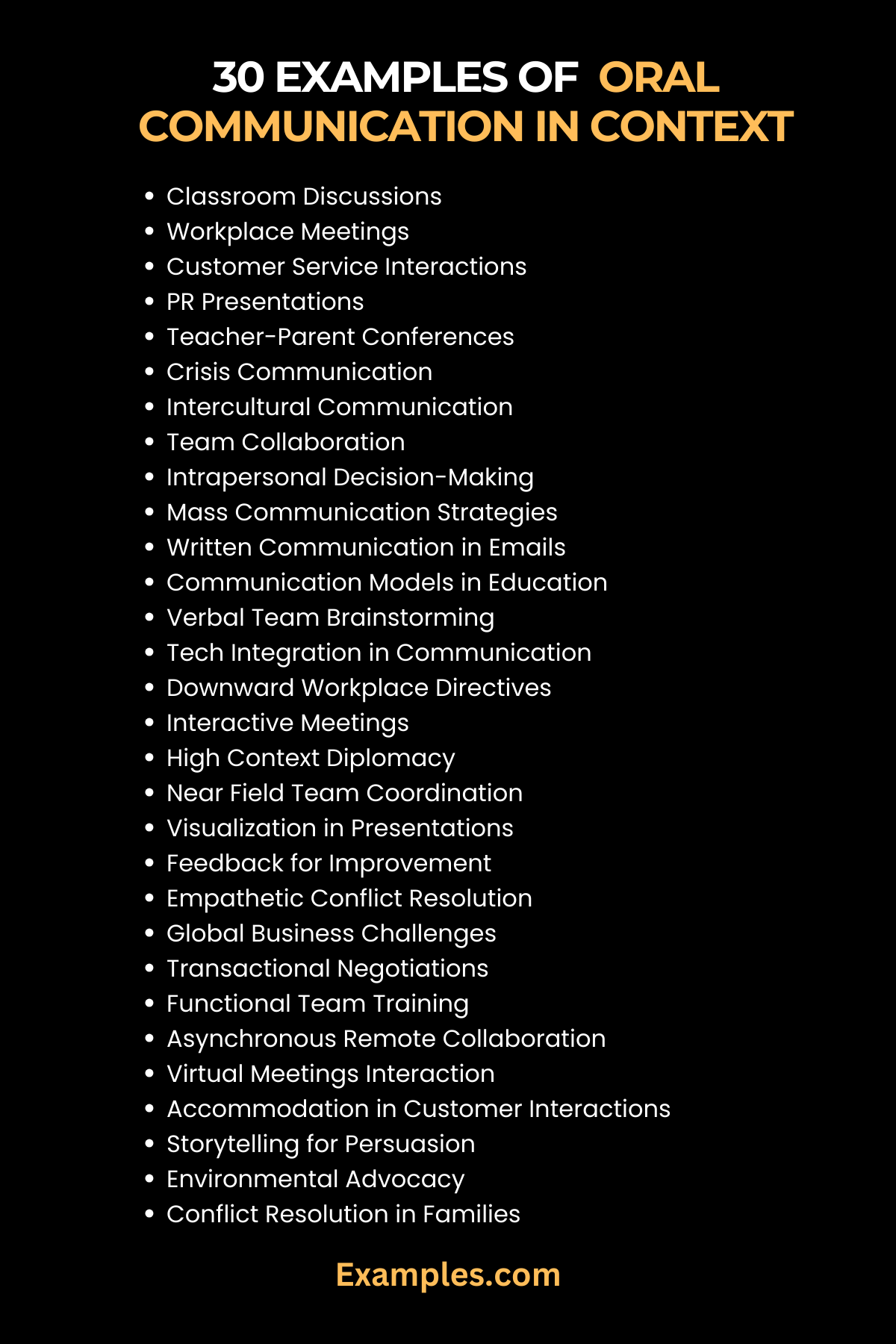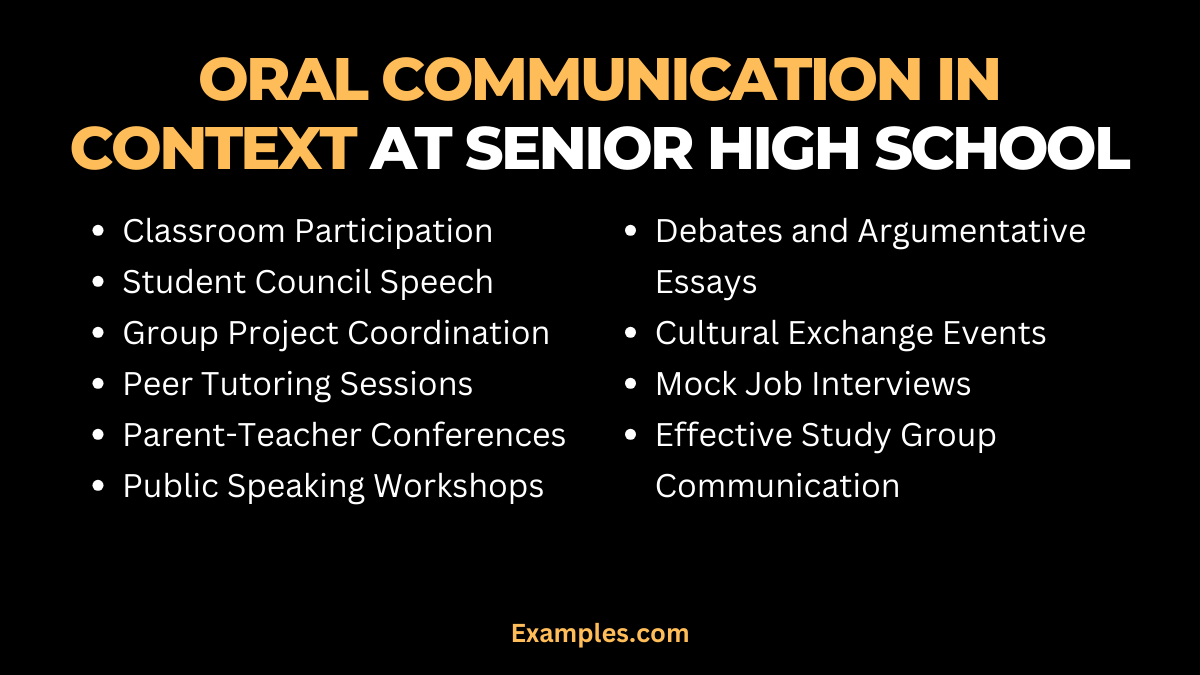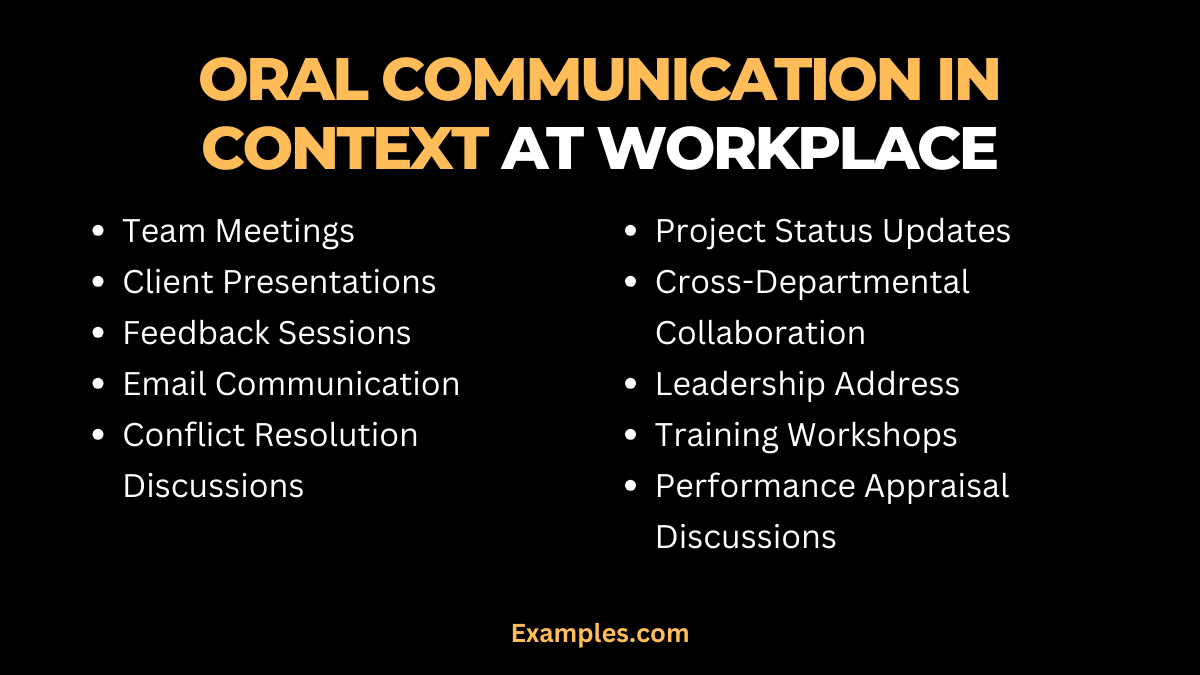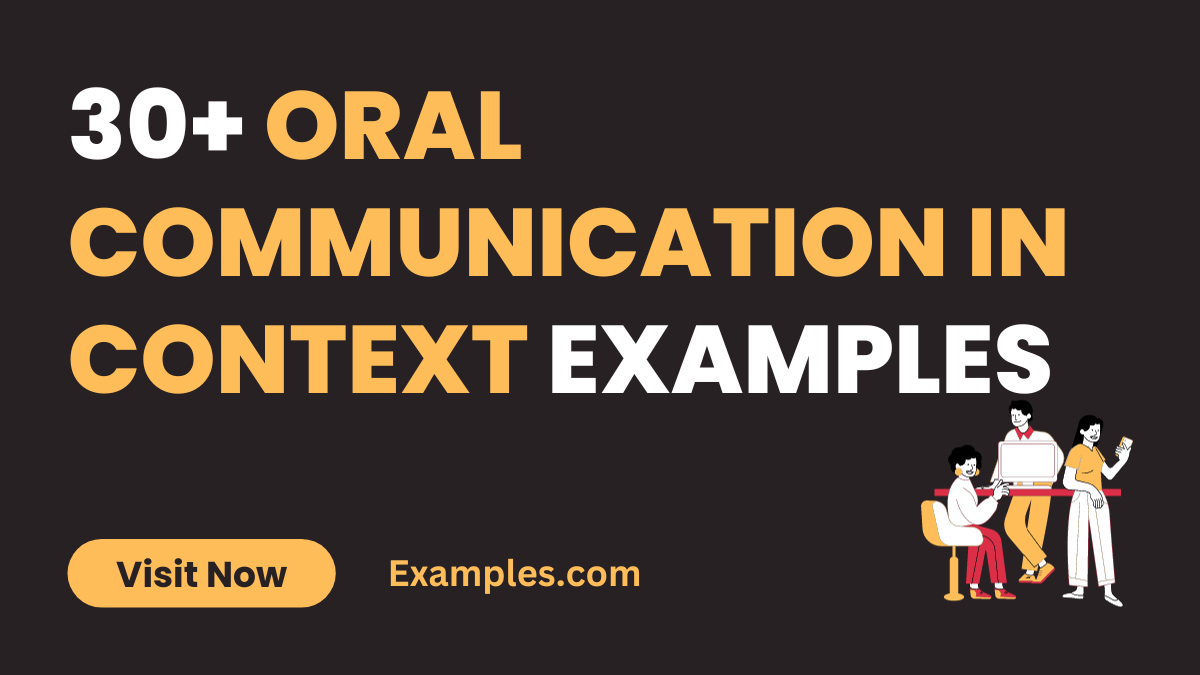19+ Oral Communication in Context Examples
Embark on a comprehensive journey into Oral Communication in Context, tailored specifically for the dynamic setting of senior high school. This guide unfolds the intricacies of effective communication, offering not only theoretical insights but real-world Communication Examples. From navigating classroom dialogues to mastering workplace interactions, delve into practical tips and strategies that empower high school students with the skills to communicate with confidence and relevance in diverse contexts.
What is Oral Communication in Context?
Oral Communication in Context refers to the art of conveying messages verbally within specific environments, such as senior high schools, workplaces, or classrooms. It involves tailoring communication styles to suit the distinctive settings, taking into account the audience, purpose, and cultural nuances. This dynamic form of expression emphasizes the relevance of effective interpersonal skills in diverse contexts, ensuring messages are not only heard but comprehended within the specific framework of each situation.
30 Examples of Oral Communication In Context
Unlock the nuances of effective communication with our curated collection of 30 Oral Communication in Context examples. From high school interactions to workplace dynamics, this comprehensive guide features diverse instances illuminating the art of verbal expression within specific settings. Elevate your communication skills by exploring these real-world scenarios, each offering valuable insights into adapting and thriving in varied contexts.

- Classroom Discussions: Engage in open dialogue to foster collaboration and deeper understanding.
Example: Boldly share your insights on the historical context of the novel, sparking enriching conversations. - Workplace Meetings: Navigate professional discussions with clarity and assertiveness.
Example: In a team meeting, use concise language to present your ideas for optimizing project efficiency. - Customer Service Interactions: Provide assistance with empathy and effective problem-solving.
Example: Address customer concerns by actively listening, acknowledging issues, and offering swift resolutions. - Public Relations Presentations: Craft persuasive narratives to enhance brand perception.
Example: Deliver a captivating PR presentation to stakeholders, emphasizing key achievements and future initiatives. - Teacher-Parent Conferences: Communicate student progress with transparency and sensitivity.
Example: Convey a student’s academic journey by highlighting achievements and discussing areas for improvement. - Crisis Communication in the Workplace: Respond to challenges with clarity and reassurance.
Example: During a crisis, communicate transparently with team members, addressing concerns and outlining a strategic plan. - Intercultural Communication: Bridge cultural gaps with respect and understanding.
Example: Navigate cross-cultural interactions by adapting your communication style to accommodate diverse perspectives. - Team Collaboration in Projects: Foster effective teamwork through clear communication channels.
Example: Coordinate project tasks by maintaining open communication, ensuring everyone is aligned with project goals. - Intrapersonal Communication in Decision-Making: Reflect on personal values and goals for informed choices.
Example: Prioritize your career goals through introspective communication, aligning actions with long-term aspirations. - Mass Communication Strategies: Disseminate information to a broad audience with impact.
Example: Develop a compelling press release, using concise language and engaging content to convey key messages. - Written Communication in Emails: Convey professionalism and clarity in digital correspondence.
Example: Craft an effective email by organizing thoughts logically and utilizing a clear and concise writing style. - Model of Communication in Educational Settings: Implement communication models for effective teaching.
Example: Apply the transactional model in the classroom, encouraging student feedback and promoting interactive learning. - Verbal Communication in Team Brainstorming: Share ideas articulately to fuel creative discussions.
Example: Contribute to a team brainstorming session by expressing thoughts clearly and building on others’ suggestions. - Communication Technology Integration: Seamlessly incorporate tech tools for streamlined communication.
Example: Utilize communication apps for project updates, ensuring real-time collaboration and information exchange. - Downward Communication in Workplace Directives: Disseminate instructions with clarity and relevance.
Example: As a manager, provide clear directives to your team, ensuring a shared understanding of expectations. - Interactive Model of Communication in Meetings: Facilitate two-way communication for productive discussions.
Example: Use the interactive model in meetings, encouraging feedback and ensuring everyone’s voice is heard. - High Context Communication in Diplomacy: Navigate diplomatic discussions with cultural sensitivity.
Example: Engage in high-context communication during international negotiations, respecting cultural nuances. - Near Field Communication in Team Coordination: Foster close communication for efficient collaboration.
Example: Implement near field communication strategies for team projects, enhancing coordination and swift information exchange. - Visualization Communication in Presentations: Enhance presentations with compelling visuals for better engagement.
Example: Incorporate infographics and visuals in presentations to convey complex information in an accessible manner. - Feedback in Communication for Performance Improvement: Offer constructive feedback to encourage growth.
Example: Provide feedback to team members, focusing on specific actions and suggesting improvements for professional development. - Empathetic Communication in Conflict Resolution: Resolve conflicts with empathy and understanding.
Example: Address interpersonal conflicts by actively listening, expressing empathy, and working collaboratively towards resolution. - Global Communication Challenges in International Business: Navigate language and cultural challenges in global business.
Example: Communicate effectively in international business by adapting to diverse communication styles and languages. - Transactional Communication in Negotiations: Engage in two-way communication during negotiations for mutual understanding.
Example: Apply the transactional model in negotiations, addressing concerns and finding common ground for agreements. - Functional Communication Training in Team Development: Foster effective communication skills within a team.
Example: Implement functional communication training to enhance team dynamics and cooperation. - Asynchronous Communication in Remote Work: Manage communication across different time zones effectively.
Example: Embrace asynchronous communication tools for remote work, allowing team members to collaborate without real-time constraints. - Interactive Model of Communication in Virtual Meetings: Promote engagement in virtual meetings with interactive communication.
Example: Utilize the interactive model in virtual meetings, encouraging active participation through polls and discussions. - Communication Accommodation Theory in Customer Interactions: Adapt communication style to meet customer needs.
Example: Apply communication accommodation theory in customer service, adjusting tone and language to ensure customer satisfaction. - Storytelling in Communication for Persuasion: Utilize storytelling techniques to persuade and captivate audiences.
Example: Craft a persuasive business proposal by incorporating storytelling elements to convey the value of your proposition. - Environmental Communication in Sustainable Practices: Communicate sustainability initiatives with clarity and passion.
Example: Advocate for environmental awareness by effectively communicating the benefits of sustainable practices in the workplace. - Conflict Resolution Communication in Family Discussions: Navigate family conflicts with open communication.
Example: Resolve family disputes by engaging in open and honest communication, addressing concerns and finding common ground.
Oral Communication in Context at Senior High School
Embark on a transformative exploration of Oral Communication in the dynamic setting of senior high school. Uncover strategies tailored for students, promoting effective dialogue in classrooms and social interactions. Master the art of expressing ideas, actively listening, and engaging with peers, setting the foundation for confident communication in academic pursuits and beyond.

- Classroom Participation: Boost learning by actively contributing to discussions, such as sharing personal insights on literature or science topics.
- Student Council Speech: Communicate leadership qualities by delivering a persuasive speech during student council elections, emphasizing vision and collaboration.
- Group Project Coordination: Facilitate effective team dynamics by organizing group discussions, ensuring everyone’s voice is heard in project planning.
- Peer Tutoring Sessions: Enhance understanding by communicating complex concepts clearly during peer tutoring sessions, fostering a collaborative learning environment.
- Parent-Teacher Conferences: Strengthen parent-teacher relationships by articulating students’ progress, addressing concerns, and collaboratively setting goals for academic growth.
- Public Speaking Workshops: Develop confidence in public speaking through workshops, where students learn to structure and deliver impactful presentations.
- Debates and Argumentative Essays: Hone persuasive skills by participating in debates or crafting argumentative essays, articulating and defending well-researched viewpoints.
- Cultural Exchange Events: Promote diversity by engaging in cultural exchange events, where students communicate and celebrate various backgrounds and traditions.
- Mock Job Interviews: Prepare for future professional interactions by participating in mock job interviews, refining communication skills for the workplace.
- Effective Study Group Communication: Maximize learning in study groups by fostering open communication, sharing study strategies, and clarifying doubts collaboratively.
Oral Communication in Context at Workplace
Navigate the intricate dynamics of communication within the workplace, mastering the art of conveying ideas, providing feedback, and fostering a collaborative environment. Explore tailored strategies for workplace interactions, enhancing both professional relationships and overall organizational communication effectiveness.

- Team Meetings: Facilitate productive team meetings by articulating goals, discussing progress, and fostering open communication for effective collaboration.
- Client Presentations: Showcase professionalism and expertise in client presentations, emphasizing clear communication to convey complex ideas in a comprehensible manner.
- Feedback Sessions: Cultivate a culture of improvement through constructive feedback sessions, addressing performance areas and acknowledging achievements.
- Email Communication: Optimize written communication in emails by ensuring clarity, conciseness, and professionalism in conveying information and instructions.
- Conflict Resolution Discussions: Navigate workplace conflicts by initiating open discussions, actively listening to concerns, and collaboratively finding resolutions.
- Project Status Updates: Enhance project management by providing regular status updates, ensuring all team members are informed and aligned with project goals.
- Cross-Departmental Collaboration: Foster synergy across departments by facilitating communication channels, ensuring seamless information exchange and collaborative problem-solving.
- Leadership Address: Inspire teams through effective leadership addresses, articulating a vision, and aligning team members with organizational goals.
- Training Workshops: Improve workplace skills through training workshops, where clear communication is pivotal in conveying new processes and best practices.
- Performance Appraisal Discussions: Conduct fair and transparent performance appraisals by clearly communicating expectations, areas of improvement, and recognizing accomplishments.
In conclusion, the guide on “Oral Communication in Context” from Examples.com provides a thorough exploration of effective verbal communication across various settings, particularly in senior high school and workplace environments. It emphasizes the significance of adapting communication styles to specific contexts, considering audience, purpose, and cultural nuances. The guide includes practical examples like fostering collaboration through classroom discussions, navigating professional meetings with clarity, and utilizing communication technology effectively.
For further insights into effective oral communication, resources like Toastmasters International, found at Toastmasters, offer valuable tools and tips for public speaking and leadership development. Additionally, the Massachusetts Institute of Technology’s OpenCourseWare, available at MIT OpenCourseWare, provides access to a range of free courses, including ones on communication skills, further enriching your understanding and application of these competencies in various contexts.



